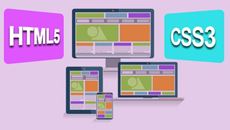- Delivery Method Online
- Professional Certificate
- 24hrs Suggested Study Time
- 3 Months Access
- Tutor Support
- Study On Any Device
- 4017 Students
Building Mobile Apps with HTML5

Learn to use HTML5, CSS3, JavaScript, jQuery, and Web APIs to create cross-platform mobile apps and mashups.
Do you want to make mobile apps that run on iPhone and iPad, as well as on Android, Blackberry, and Windows Phone? Sure you do! Do you want to learn five different programming languages? Of course you don't!
Fortunately, you're about to discover a better way to build apps. In this course, you'll learn how to imagine, design, build, and optimise a cross-platform mobile app using the very latest HTML5 standards. The result will be a mobile app that's fast and runs on just about any smartphone or tablet computer.
You'll also learn some of the most sought-after skills in Web and mobile development, including:
- HTML5 and how it's different from previous versions of HTML.
- CSS3, the layout and styling language of the mobile Web.
- Scripting with JavaScript and several JavaScript frameworks and techniques such as jQuery, jQuery Mobile, and AJAX.
- How to use Web services such as Google Maps in your app.
- How to determine an app's user location by accessing the built-in geolocation capabilities of the user's smartphone.
- How to use Web Application Programming Interfaces (Web APIs) to combine different Web services to create mobile mashups.
- How to optimise your app for performance to make sure that it runs as fast as possible for your users.
- How to convert your HTML5 apps into native apps that you can submit to app stores such as Apple's App Store, Google Play, and Blackberry App World.
By the end of the course, you'll have built your first mobile web app, and you'll be on your way to making your dream of being a successful mobile app developer a reality!
Course Revised January 2014​
Courses are delivered to you through expertly executed lessons, online instruction and interaction with like-minded students. Our courses are designed to deliver all of the benefits of studying in a classroom whilst giving you the flexibility to study at a time and place to suit your needs. You can access your classroom 24/7 from any device with an internet connection.
This course has a 3 month duration. You'll complete comprehensive lessons, quizzes and assignments before submitting your final exam at the end of the course to achieve your certificate. Courses must be completed within the 3 month access period.

Chris Minnick
Chris Minnick has helped hundreds of businesses design or redesign their websites, mobile websites, and mobile apps. As the founder of Minnick Web Services, he has over 18 years of experience working with clients ranging from sole proprietors to F... Read more
Read Chris Minnick's ProfileFrequently Asked Questions
What people are saying about our courses
The Learning Environment
From the moment that you enrol in the Building Mobile Apps with HTML5 you will become an integral part of our learning community. You'll find yourself with the freedom to learn at a speed that suits you, on any device, from anywhere in the world. Achieving your career goals no longer has to mean compromising family and work commitments.
Ready to get started?
Enrol NowOur Values
Learn At Your Own Pace
We believe in personalised learning. That's why we provide all the tools and support you need to succeed at your own pace. With flexible learning, you'll stay motivated and retain more information. Plus, you can balance your studies with work and family commitments to make your dreams a reality.
We Won't Break The Bank
Education should be accessible to anyone who wants to learn. That's why we offer some of the most competitive prices in the industry with payments plans for just $25 per week. Investing in your future is a smart choice and doesn’t have to break the bank.
Industry-Led Courses
There's no better way to learn than from experts with years of experience in your field. That's why each of our 200+ industry-led courses are designed to give you a real-life perspective on your industry. With our expert mentors, you'll learn from people who have a wealth of knowledge and experience, and who are passionate about sharing it with you.
Get The Personal Support You Deserve
At Vibe Learning, we're real people who are dedicated to providing you with personal support every step of the way. Our industry experts are not only professional and knowledgeable but also incredibly passionate about sharing their expertise with you. With their guidance, you'll gain invaluable insights and practical knowledge to help you succeed.
Still looking?
Check out the following courses related to Building Mobile Apps with HTML5:



